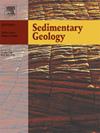Types and formation mechanisms of authigenic quartz in the Late Paleozoic alkaline lacustrine shales, NW China
IF 2.9
2区 地球科学
Q1 GEOLOGY
引用次数: 0
Abstract
Authigenic quartz controls the storage and mechanical properties of shales, and has attracted a growing attention in marine and continental shales. The silica solubility in alkaline lakes is high due to the high lake water pH (>9) and thus alkaline lacustrine shales generally contain abundant authigenic quartz. However, the occurrences and formation of authigenic quartz in alkaline lacustrine shales and its impact on shales remain poorly studied. To solve these problems, we systematically studied the Late Paleozoic alkaline lacustrine Fengcheng Formation in the Mahu Sag of the Junggar Basin via optical microscope and scanning electron microscope observations and elemental analyses. Four types of authigenic quartz have been identified in the Fengcheng Formation (shales): chert nodules or bands, matrix-dispersed microquartz, mineral-replacive quartz, and veins-filling quartz. The Fengcheng Formation shales contain excess SiO2 ranging from 11.3 % to 60.4 % based on element calculation and matrix-dispersed microquartz is the dominant type of authigenic quartz, followed by cherts. Cherts and matrix-dispersed microquartz were formed during syndepositional to early diagenetic stage, sourced from pH-driven dissolution of detrital quartz grains and transformation of volcanic materials in highly alkaline water. Both chert and matrix-dispersed microquartz formation can increase the rock strength of shales while matrix-dispersed microquartz can also form massive intercrystalline pores and protect the micropores from compaction. In contrast with marine and non-alkaline lacustrine siliceous shales, alkaline lacustrine shales have a higher abundance and more formation stages of authigenic quartz, and can form high-quality shale reservoirs with high contents of organic matter and authigenic quartz in shallow-water zone.

晚古生代碱性湖相页岩自生石英类型及形成机制
自生石英控制着页岩的储层和力学性质,在海相和陆相页岩中引起了越来越多的关注。碱性湖泊水体pH值高(>9),硅的溶解度高,因此碱性湖泊页岩一般含有丰富的自生石英。然而,对碱性湖相页岩中自生石英的赋存、形成及其对页岩的影响的研究还很少。为解决这些问题,通过光学显微镜、扫描电镜观察和元素分析,对准噶尔盆地马湖凹陷晚古生代碱性湖泊丰城组进行了系统研究。在丰城组(页岩)中发现了4种自生石英:燧石结核或带状石英、基质分散微石英、矿物替代石英和脉状充填石英。丰城组页岩SiO2含量在11.3% ~ 60.4%之间,自生石英以基质分散微石英为主,其次为燧石;燧石和基质分散微石英形成于同沉积至早期成岩阶段,主要来源于高碱性水体中碎屑石英颗粒的ph驱动溶蚀和火山物质的转化。燧石组和基质分散微石英组均能提高页岩岩石强度,基质分散微石英组还能形成块状晶间孔,保护微孔不被压实。与海相和非碱性湖相硅质页岩相比,碱性湖相页岩自生石英丰度更高,形成期次更多,可形成浅水区有机质和自生石英含量高的优质页岩储层。
本文章由计算机程序翻译,如有差异,请以英文原文为准。
求助全文
约1分钟内获得全文
求助全文
来源期刊

Sedimentary Geology
地学-地质学
CiteScore
5.10
自引率
7.10%
发文量
133
审稿时长
32 days
期刊介绍:
Sedimentary Geology is a journal that rapidly publishes high quality, original research and review papers that cover all aspects of sediments and sedimentary rocks at all spatial and temporal scales. Submitted papers must make a significant contribution to the field of study and must place the research in a broad context, so that it is of interest to the diverse, international readership of the journal. Papers that are largely descriptive in nature, of limited scope or local geographical significance, or based on limited data will not be considered for publication.
 求助内容:
求助内容: 应助结果提醒方式:
应助结果提醒方式:


